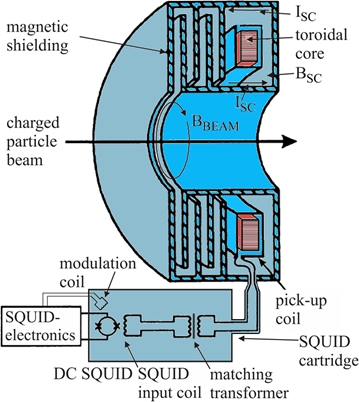Ion Beam Diagnosis Using Cryogenic Current Comparators
SQUIDs (superconducting quantum interference devices) are widely used in various fields of high-precision measuring technology. Their field of application covers fundamental as well as applied research, such as biomedicine, geophysics, and high-energy physics.
Non-destructive measurements and monitoring of particle accelerator beam currents represent an ambitious technical exercise, as conventional methods of measurement may influence the beam’s profile or intensity. Alternatively, a beam monitoring system based on a cryogenic current comparator (CCC) may nonreactively determine the magnetic field generated by the moving charged particles.
A CCC consists of a highly sensitive DC SQUID system, a circular, superconducting pick-up coil and a meander-formed superconducting niobium shielding. Its operating temperature lies below 4.2 K, realized by liquid helium cooling.
CCCs allow the measurement of both continuous and pulsed beam currents on the order of nA, currently being the most sensitive class of devices to nonreactively determine even the lowest beam currents, in a frequency range between DC and several kHz.
To achieve a high measurement signal resolution, the shielding has to efficiently suppress external interference fields, while directing the beam’s azimuthal field to the pick-up coil without hindrance.
The detector’s resolution and its response function critically depend upon the physical properties of the circular pick-up coil and of the embedded ferromagnetic core. To optimize a CCC with respect to improving its signal-to-noise ratio and enlarging its transfer bandwidth, investigations regarding the relative permeability’s dependency on frequency and temperature, as well as the noise contributions by the ferromagnetic core, are crucial.

At GSI Darmstadt, an earlier project verified that the intensity of an ion beam extracted from a synchrotron could be measured with a SQUID-based CCC. It achieved a noise-limited current resolution of 250 pA/√Hz at a measurement bandwidth of approximately 50 kHz.
In the framework of a project realized in collaboration with DESY Hamburg, a SQUID-based CCC to detect dark currents of superconducting cavities was tested, achieving a noise-limited resolution of less than 200 pA/√Hz.
Fundamental limitations to noise reduction are established by the properties of the ferromagnetic core. Our research suggests that nanocrystalline ferromagnetic alloys, because of their high permeability and low noise contributions at 4.2 K, show considerable advantages when it comes to incorporation into a CCC. Use of this core materials significantly reduces detector noise.
Within the FAIR project (Facility for Antiproton and Ion Research), an improved SQUID-based CCC is intended to be used as diagnosis device for ion beams that consist of antiprotons or uranium ions, with particle numbers between 104 and 1012. At an extraction time of 5 s, this corresponds to a maximum beam current of about 32 nA or 900 nA for antiprotons or U28+ ions, respectively.
Relevant Publications:
V. Tympel et al., The Next Generation of Cryogenic Current Comparators for Beam Monitoring (2017)
R. Geithner et al., Cryogenics 54, 16 (2013)
R. Geithner et al., IEEE Trans. Appl. Supercond. 21, 444 (2011)
R. Geithner et al., Rev. Sci. Instrum. 82, 013302 (2011)
A. Steppke et al., IEEE Trans. Appl. Supercond. 19, 768 (2009)
